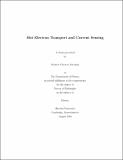Hot Electron Transport and Current Sensing
Author(s)
Abraham, Mathew Cheeran
DownloadAbraham TR#715.pdf (966.3Kb)
Metadata
Show full item recordAbstract
The effect of hot electrons on momentum scattering rates in a two-dimensional
electron gas is critically examined. It is shown that with hot electrons it is possible to
explore the temperature dependence of individual scattering mechanisms not easily
probed under equilibrium conditions; both the Bloch-Gr¨uneisen (BG) phonon scattering
phenomena and the reduction in impurity scattering are clearly observed. The
theoretical calculations are consistent with the results obtained from hot electrons
experiments. As a function of bias current, a resistance peak is formed in a 2DEG if
the low temperature impurity limited mobilities ¹I(T = 0) is comparable to ¹ph(TBG)
the phonon limited mobility at the critical BG temperature. In this case, as the bias
current is increased, the electron temperature Te rises due to Joule heating and the
rapid increase in phonon scattering can be detected before the effect of the reduction
in impurity scattering sets in. If ¹I(T = 0) ≪ ¹ph(TBG), there is no peak in resistance
because the impurity scattering dominates sufficiently and its reduction has a much
Abstract iv
stronger effect on the total resistance than the rise in phonon scattering.
Furthermore, knowing the momentum relaxation rates allows us to analyze the
possible interplay between electron-electron and electron-boundary scattering. The
prediction that a Knudsen to Poiseuille (KP) transition similar to that of a classical
gas can occur in electron flow [26] is examined for the case of a wire defined in a
2DEG. Concurrently, an appropriate current imaging technique to detect this transition
is sought. A rigorous evaluation of magnetic force microscopy (MFM) as a
possible candidate to detect Poiseuille electronic flow was conducted, and a method
that exploits the mechanical resonance of the MFM cantilever was implemented to
significantly improve its current sensitivity.
Description
Rajeev J. Ram (Massachusetts Institute of Technology)
Robert M. Westervelt (Harvard University)
Date issued
2006-08-23Series/Report no.
Technical Report (Massachusetts Institute of Technology, Research Laboratory of Electronics);715